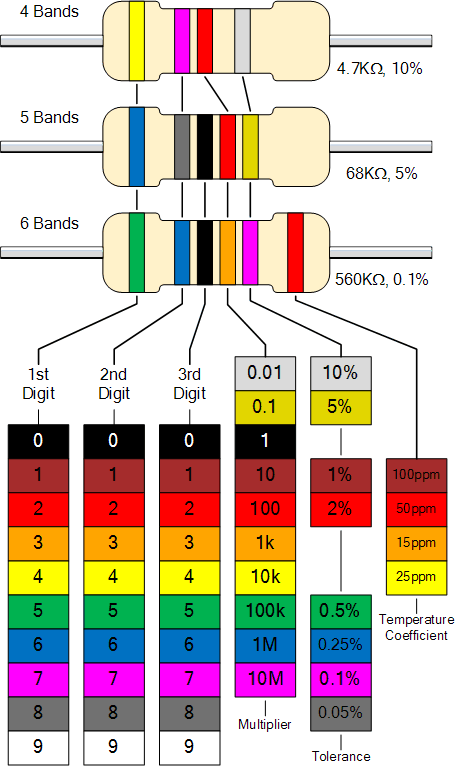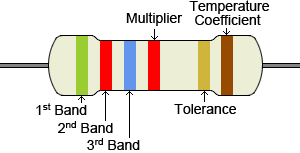How to read resistor color code value? In this article you’ll get a detailed tutorial on what is resistor color coding and how to identify the value of resistors correctly using these color bands.

As you can see in above image there are several color bands on the body of the resistors. I am pretty sure you have seen this type of bands while working with resistors. you may probably know why this bands are for, but for those who doesn’t know, this bands are for color coding of resistors. we can calculate the value of resistors using this color bands.
there are several methods of calculating the value of resistors. and one of them is to use ohm meter which is mostly a part of the multimeter. measuring the resistance using multimeter is quite simple. I will cover that in my upcoming tutorials.
You may wonder if there are easy ways of measuring the resistance why to learn resistor color coding. the answer is; because there are certain conditions where you may need to use color bands to determine the value of resistor. such as to verify if resistor is good or bad, you can measure the resistance using the multimeter and then verify that using the color coding. or you may need to know the value of resistor but you don’t have access to multimeter. in such cases this technique will be very useful.
Resistor Color Coding
How to read the resistance value using color bands. let’s see how it’s done.
There are 4, 5 and 6 band resistors available.
For 4 Band Resistors
In 4 band resistors first 2 bands are 1st and 2nd digit, the 3rd band is for the multiplier and 4th one is for the tolerance.
For 5 Band Resistors
In 5 band resistors first 3 bands are 1st, 2nd and 3rd digit, the 4rd band is for the multiplier and 5th one is for the tolerance.
For 6 Band Resistors
In 6 band resistors first 3 bands are 1st, 2nd and 3rd digit, the 4th band is for the multiplier, the 5th one is for the tolerance and the 6th band is for the temperature coefficient.
Resistor color code chart
The following chart shows complete color coding values for 4, 5 and 6 band resistors

Calculating the resistor color code value
Resistor color coding is the best method to calculate the value of resistors as it doesn’t require any additional tool. All you need to do is learn the proper method to calculate it.
The first band in the resistor is the one which is nearest to connecting lead of resistor. so the following bands would be 2nd, 3rd and 4th for 4 band resistor one additional 5th band will be there for 5 band resistor and if it’s 6 band resistor there will be 6th band.
For 4 band resistors
for 4 band resistors First and Second band will be the 1st and 2nd digit, the 3rd band will be multiplier and the 4th, which is last one that will be the tolerance.
so let’s take an example of a 4 band resistor and calculate it’s value using color code.

First Band – RED – 1st Digit is 2
Second Band – VIOLET – 2nd Digit is 7
Third Band – GREEN – Multiplier is x105 = x100K
Fourth Band – GOLD – Tolerance is +/- 5%
The value of the Resistor is 2.7M +/- 5% Tolerance
For 5 band resistors
For 5 band resistors First, Second and 3rd band will be the 1st,2nd and 3rd digit, the 4th band will be multiplier and the 5th, which is last one that will be the tolerance.
so let’s take an example of a 5 band resistor and calculate it’s value using color code

First Band – BROWN – 1st Digit is 1
Second Band – GREEN – 2nd Digit is 5
Third Band – RED – 3rd Digit is 2
Fourth Band – BLUE – Multiplier is x106 = x1M
Fifth Band – VIOLET – Tolerance is +/- 0.1%
The value of the Resistor is 152M +/- 0.1% Tolerance
For 6 band resistors
for 6 band resistors First, Second and 3rd band will be the 1st, 2nd and 3rd digit, the 4th band will be multiplier, the 5th band will be the tolerance and the 6th band which is last one that will be the temperature coefficient.
so let’s take an example of a 6 band resistor and calculate it’s value using color code.

Third Band – GREEN – 1st Digit is 5
Second Band – RED – 2nd Digit is 2
Third Band – BLUE – 3rd Digit is 6
Fourth Band – RED – Multiplier is x102 = x100
Fifth Band – GOLD – Tolerance is +/- 5%
Sixth Band – BROWN – Temperature Coefficient is 100 ppm
The value of the Resistor is 52.6K +/- 5% Tolerance 100 ppm
Band Information for 4, 5 and 6 band resistor

You can refer above chart to know which band is for what (digit/multiplier/tolerance/temp coefficient)
so that’s all you need to know to calculate the resistor values using color code learn the color codes and this method it will be helpful to you for lifetime if you are an electronics engineer/hobbyist/maker.
I hope you liked this article. please share your thoughts with us through comments, don’t forget to follow us on Facebook and Instagram and do subscribe to our Youtube Channel.
you can read our privacy policy here, to know more about ElectroBuddy and it’s vision read about us.

Nice information for a beginner. Keep it up 😃
Thanks, Glad you liked it, stay tuned for more such informative posts about basic and advanced electronics.
Very nice information 👍😊
Thanks, Glad you liked it, stay tuned for more informative posts.